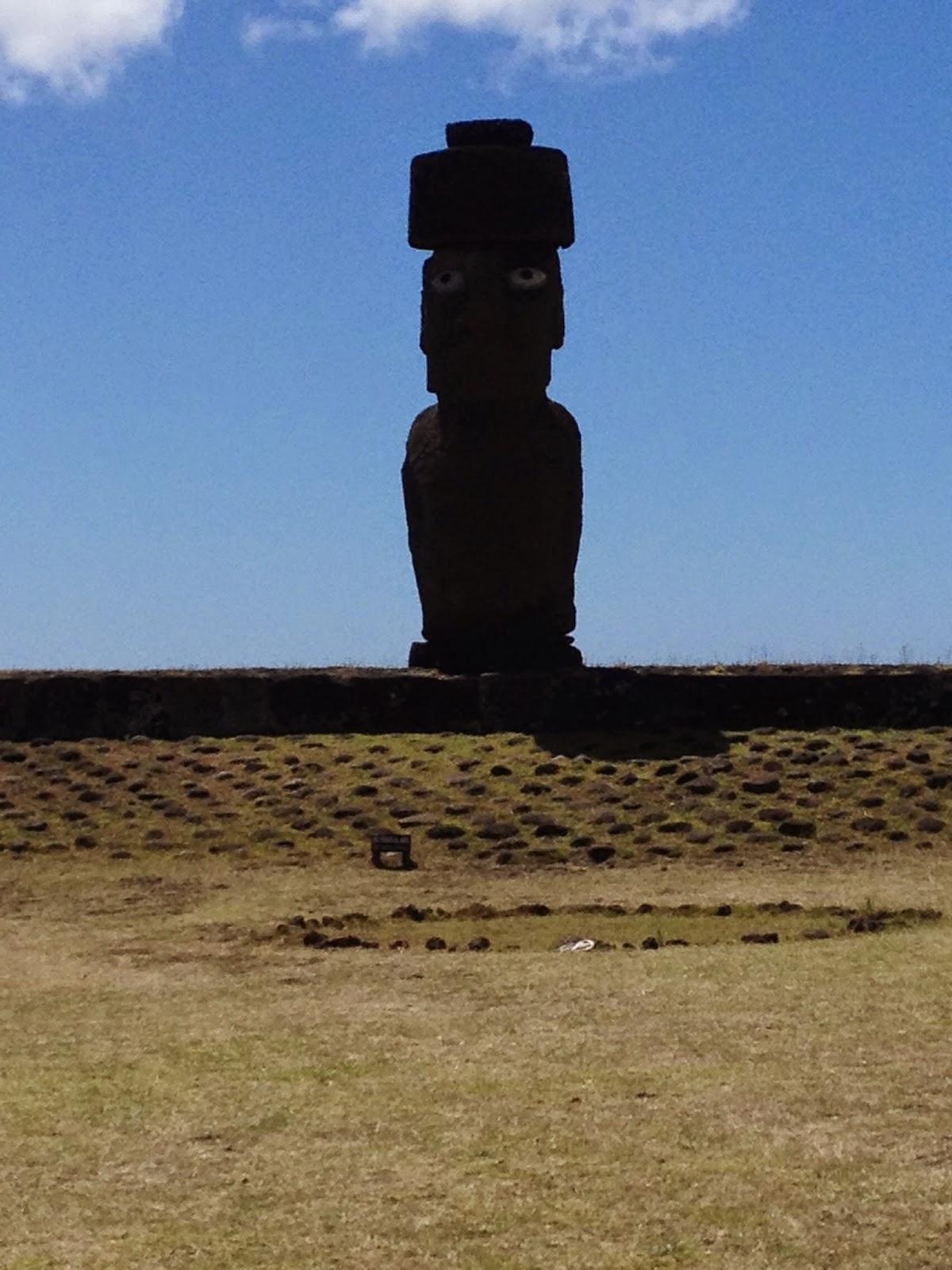Our guide (seen below), Edmundo Edwards, is an archaeologist who has lived on the island for fifty years and has worked on many of the excavations. Needless to say, we felt very well informed by the end of the day.
 |
| Isn't that the best name! |
Our first stop was at Rano Kau. This is an extinct volcano that looks nothing like any crater I've ever seen. The general environment of Easter Island is dry and breezy - surprisingly dry, as a matter of fact - but this crater is protected from these drying winds, leaving it marshy, swampy, lush and full of vines and figs. Yes, figs. There is a rather mythical feel to this place.
 |
| Rano Kau |
Mythical is a word that easily describes much of Rapa Nui. The raison d'être of Easter Island is the mammoth moai that are placed in several distinct locations around the island. There are many mysteries and a number of theories surrounding these mesmerizing statues but precious little evidence to support them. Many believe that they were carved to honour ancestors. This is no doubt true as similar lore exists in other Polynesian cultures. However, questions remain having to do with how they were transported to their current locations from the quarry where they were created and then why they were found toppled over many centuries later.
 Rano Raraku is the site where the moai were carved directly out of the rock. Some still reside there, flat on their backs, their spines never having been detached from the stone. Others lie outside the quarry itself, lying flat or half buried in the ground, centuries of earth having gathered around them.
Rano Raraku is the site where the moai were carved directly out of the rock. Some still reside there, flat on their backs, their spines never having been detached from the stone. Others lie outside the quarry itself, lying flat or half buried in the ground, centuries of earth having gathered around them.
Now, it is from here that scientists, archaeologists, anthropologists, etc. disagree about how these statues were transported to their final spot. Some believe that the island was deforested (and there are, indeed, no trees) because the natives chopped them all down in order to make a path along which each moai was rolled in a horizontal position. Another theory, on which a documentary has recently been made, is that they were "walked" to their destination. There is some lore about elders that says that when one of them was asked how the moai were moved, the response was "they walked." Some scientists believe this meant that a statue was tied around its neck and shoulders and rocked to its place in a vertical position. This method has been proven, however, it would take an inordinate amount of time and a lot of manpower, not to mention the fact that the natives didn't really have the resources for making rope. The most accepted theory is the notion that each statue was rolled horizontally on a few logs that were moved forward in line toward the final destination; the deforestation was caused by the destruction of the trees' bark by goats.
Ahu Tongariki is an altar featuring these spectacular creations. When this area was first discovered, the moia were toppled over and scattered around a vast area nearby. There are many who believe that they were intentionally knocked down by warring families - and in other places this may be the reason - but our guide is certain that these fifteen were pushed over by earthquakes and tidal waves. The ancient natives didn't have the technology to re-erect them. It was not until a Japanese company in the 1970's offered the services of their crane that this altar was returned to its original formation. Contrary to my husband's silliness (below), this is a very spiritual place. The majesty of the moai is quite moving. These creatures have been sculpted with great respect; the past is clearly an important element to the belief system of these ancient peoples.
The next stop had a different atmosphere. Anakena Beach is the only sand beach on the island. Apparently, the locals prefer the rocky beaches as they are good places to fish and the tide pools make it safer for their children. So, the atmosphere at this more traditional beach was more high energy. There were huts at the entrance to the area serving drinks and food; barbecues were fired up and people enjoyed a meal at the scattered picnic tables. But this is still a place for contemplation - above the beach itself sits a smaller altar of moai. Alhough they don't face the water, it still has a protective feel to it - as if the ancestors are watching over their families.
The final stop was Ahu Tahai. It is a ceremonial complex along the coast where two grass covered stone houses lie. There are three separate altar areas that were excavated by an American, William Mulloy. His grave is nearby. One altar contains six moai, although one is not standing. Some speculate that the two largest may represent parents and the remaining smaller ones, children. There are others who believe that the larger ones may be tribal leaders who are with their members.
There is a single moai to the right (not in the photo) that is severely degraded from centuries of wind and saltwater erosion.
And to the right of that one is the only moai on the island that has white shells around the pupils of the eyes. Other statues on the island never had these or they fell off many years ago. These shells seem to bring the moai to life.
Heery and I agree that this was one of the most remarkable places we have visited in our various travels. It is certainly a place where we want to return.
Our ship awaits







No comments:
Post a Comment